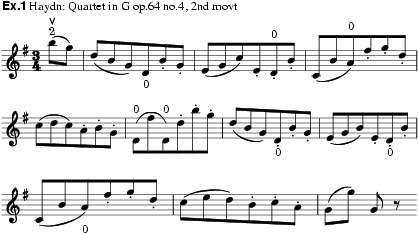
(Fr.: ‘odd mixture of colours’).
A 19th-century term used in bowed instruments to describe several slightly unorthodox ways of mixing open strings with stopped notes for special effect. This may merely be a matter of using open strings in passages otherwise played in upper positions. In L’art du violon (1834) Baillot (who explains the name of the device by saying that it seems ‘disordered or bizarre’) cites Haydn’s fingering indications in the trio of his G major Quartet op.64 no.4 (ex.1). The term is most frequently applied to the special effect in which the same note is played alternately on two strings – one stopped and one open – resulting in the juxtaposition of contrasting tone-colours (a kind of Klangfarbenmelodie). Bariolage may be produced either by slurred bowing or by individual bowstrokes. Well-known examples occur in the prelude of Bach’s Partita in E for solo violin (ex.2). The device is similar to Ondulé or ondeggiando (though this does not necessarily involve the use of open strings). See Bow, §II, 2(viii).


DAVID D. BOYDEN/PETER WALLS